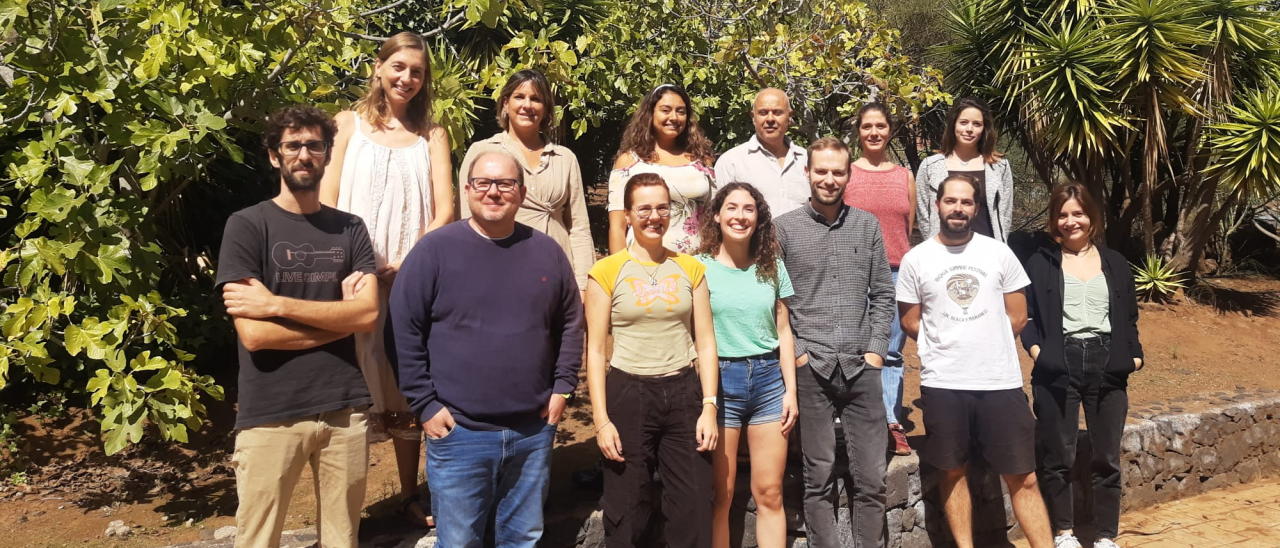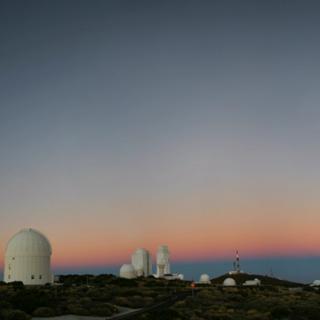Subvenciones relacionadas:
General
Bienvenida a la página web del grupo de investigación Traces of Galaxy Formation.
Somos un grupo de investigación amplio, diverso y muy activo cuyo objetivo principal es entender la formación de galaxias en el Universo de una manera lo más completa posible. Con el estudio detellado de las poblaciones estelares como bandera, estamos constantemente buscando y desarrollando nuevas herramientas e ideas que nos permitan entender cómo las galaxias han llegado a convertirse en lo que hoy observamos.
Una historia de formación compleja, como la que se espera describa la evolución de las galaxias, necesita de un acercamiento multidisciplinar para ser entendida. Nuestro grupo en el IAC está compuesto por personal investigador de gran experiencia en simulaciones cosmológicas, estudios dinámicos, análisis de poblaciones estelares y caracterizaciones morfológicas de galaxias tanto locales como a alto corrimiento al rojo. Combinamos distintas alternativas (e.g. observaciones y teoría o procesos de evolución secular y cosmológica) para poder alcanzar en los próximos años una visión consistente de los mecanismos físicos que regulan la formación de las galaxias.
Dentro de este esquema general, estamos principalmente centrados en el estudio de tres líneas centrales:
- Modelos de síntesis de poblaciones estelares
- Desarrollo de modelos de poblaciones estelares
- Métodos de análisis para el estudio de poblaciones estelares
- Universalidad de la función inicial de masa (IMF)
- Evolución cósmica de galaxias
- Evolución de galaxias masivas
- Poblaciones estelares en distintos entornos
- Ciencia a bajo brillo superficial
- Simulaciones númericas y aprendizaje automático
- Procesos evolutivos en galaxias cercanas
- Agujeros negros como moduladores de la formación estelar
- Cartogrtafiados locales
- Cinemática estelar y modelos dinámicos
Si quieres ponerte en contacto o trabajar con el grupo, por favor, envía un correo al investigador principal (Ignacio Martín-Navarro ignacio.martin [at] iac.es (ignacio[dot]martin[at]iac[dot]es)).
Miembros
Resultados
Esta es una muestra de algunos de nuestros resultados destacados más recientes:
- Local variations of the stellar velocity ellipsoid - II. The effect of the bar in the inner regions of Auriga galaxies. Walo et al. 2022, MNRAS (https://ui.adsabs.harvard.edu/abs/2022MNRAS.513.4587W)
- Anisotropic satellite galaxy quenching modulated by black hole activity. Martín-Navarro et al. 2021, Nature (https://ui.adsabs.harvard.edu/abs/2021Natur.594..187M)
- Evaluating hydrodynamical simulations with green valley galaxies. Angthopo et al. 2021, MNRAS (https://ui.adsabs.harvard.edu/abs/2021MNRAS.502.3685A)
- Sub one per cent mass fractions of young stars in red massive galaxies. Salvador-Rusiñol et al. 2020, Nature Astronomy (https://ui.adsabs.harvard.edu/abs/2020NatAs...4..252S)
- Detection of young stellar populations in apparently quenched low-mass galaxies using red spectral line indices. de Lorenzo-Cáceres et al. 2020, MNRAS (https://ui.adsabs.harvard.edu/abs/2020MNRAS.498.1002D)
Actividad científica
Publicaciones relacionadas
-
The cosmic assembly of stellar haloes in massive early-type Galaxies
Using the exquisite depth of the Hubble Ultra Deep Field (HUDF12 programme) data set, we explore the ongoing assembly of the outermost regions of the most massive galaxies (Mstellar ≥ 5× 1010 M⊙) at z ≤ 1. The outskirts of massive objects, particularly early-type Galaxies (ETGs), are expected to suffer a dramatic transformation across cosmic time
Buitrago, Fernando et al.Fecha de publicación:
42017 -
Stellar content of extremely red quiescent galaxies at z > 2
Context. A set of 20 extremely red galaxies at 2.5 ≤ zphot. ≤ 3.8 with photometric features of old passive-evolving galaxies without dust, with stellar masses of 1011M⊙, have colors that could be related to passive-evolving galaxies with mean ages larger than 1 Gyr. This suggests they have been formed, on average, when the Universe was very young (
López-Corredoira, M. et al.Fecha de publicación:
42017 -
Baade's window and APOGEE. Metallicities, ages, and chemical abundances
Context. Baade's window (BW) is one of the most observed Galactic bulge fields in terms of chemical abundances. Owing to its low and homogeneous interstellar absorption it is considered the perfect calibration field for Galactic bulge studies. Aims: In the era of large spectroscopic surveys, calibration fields such as BW are necessary for cross
Schultheis, M. et al.Fecha de publicación:
32017 -
Space Telescope and Optical Reverberation Mapping Project. V. Optical Spectroscopic Campaign and Emission-line Analysis for NGC 5548
We present the results of an optical spectroscopic monitoring program targeting NGC 5548 as part of a larger multiwavelength reverberation mapping campaign. The campaign spanned 6 months and achieved an almost daily cadence with observations from five ground-based telescopes. The Hβ and He ii λ4686 broad emission-line light curves lag that of the
Pei, L. et al.Fecha de publicación:
32017 -
The Nearest Ultra Diffuse Galaxy: UGC 2162
We describe the structural, stellar population and gas properties of the nearest ultra diffuse galaxy discovered so far: UGC 2162 (z = 0.00392 {R}e,g=1.7(+/- 0.2) kpc; {μ }g(0) = 24.4 ± 0.1 mag arcsec‑2 g-i = 0.33 ± 0.02). This galaxy, located at a distance of 12.3(±1.7) Mpc, is a member of the M77 group. UGC 2162 has a stellar mass of ∼ 2{(}-1+2)
Trujillo, I. et al.Fecha de publicación:
22017 -
Chemical tagging with APOGEE: discovery of a large population of N-rich stars in the inner Galaxy
Formation of globular clusters (GCs), the Galactic bulge, or galaxy bulges in general is an important unsolved problem in Galactic astronomy. Homogeneous infrared observations of large samples of stars belonging to GCs and the Galactic bulge field are one of the best ways to study these problems. We report the discovery by APOGEE (Apache Point
Schiavon, R. P. et al.Fecha de publicación:
22017 -
Chemical Abundances of M-dwarfs from the APOGEE Survey. I. The Exoplanet Hosting Stars Kepler-138 and Kepler-186
We report the first detailed chemical abundance analysis of the exoplanet-hosting M-dwarf stars Kepler-138 and Kepler-186 from the analysis of high-resolution (R ∼ 22,500) H-band spectra from the SDSS-IV–APOGEE survey. Chemical abundances of 13 elements—C, O, Na, Mg, Al, Si, K, Ca, Ti, V, Cr, Mn, and Fe—are extracted from the APOGEE spectra of
Souto, D. et al.Fecha de publicación:
22017 -
Two-dimensional multi-component photometric decomposition of CALIFA galaxies
We present a two-dimensional multi-component photometric decomposition of 404 galaxies from the Calar Alto Legacy Integral Field Area data release 3 (CALIFA-DR3). They represent all possible galaxies with no clear signs of interaction and not strongly inclined in the final CALIFA data release. Galaxies are modelled in the g, r, and i Sloan Digital
Méndez-Abreu, J. et al.Fecha de publicación:
12017 -
Space Telescope and Optical Reverberation Mapping Project.VI. Reverberating Disk Models for NGC 5548
We conduct a multiwavelength continuum variability study of the Seyfert 1 galaxy NGC 5548 to investigate the temperature structure of its accretion disk. The 19 overlapping continuum light curves (1158 \mathringA to 9157 \mathringA ) combine simultaneous Hubble Space Telescope, Swift, and ground-based observations over a 180 day period from 2014
Starkey, D. et al.Fecha de publicación:
12017 -
APOGEE chemical abundances of globular cluster giants in the inner Galaxy
We report chemical abundances obtained by Sloan Digital Sky Survey (SDSS)-III/Apache Point Observatory Galactic Evolution Experiment for giant stars in five globular clusters located within 2.2 kpc of the Galactic Centre. We detect the presence of multiple stellar populations in four of those clusters (NGC 6553, NGC 6528, Terzan 5 and Palomar 6)
Schiavon, R. P. et al.Fecha de publicación:
42017 -
Galactic archaeology with asteroseismology and spectroscopy: Red giants observed by CoRoT and APOGEE
With the advent of the space missions CoRoT and Kepler, it has recently become feasible to determine precise asteroseismic masses and relative ages for large samples of red giant stars. We present the CoRoGEE dataset, obtained from CoRoT light curves for 606 red giants in two fields of the Galactic disc that have been co-observed by the Apache
Anders, F. et al.Fecha de publicación:
12017 -
Stellar kinematics across the Hubble sequence in the CALIFA survey: general properties and aperture corrections
We present the stellar kinematic maps of a large sample of galaxies from the integral-field spectroscopic survey CALIFA. The sample comprises 300 galaxies displaying a wide range of morphologies across the Hubble sequence, from ellipticals to late-type spirals. This dataset allows us to homogeneously extract stellar kinematics up to several
Falcón-Barroso, J. et al.Fecha de publicación:
12017 -
The inner mass distribution of late-type spiral galaxies from <monospace>SAURON</monospace> stellar kinematic maps
We infer the central mass distributions within 0.4-1.2 disc scalelengths of 18 late-type spiral galaxies using two different dynamical modelling approaches - the asymmetric drift correction (ADC) and axisymmetric Jeans anisotropic multi-Gaussian expansion (JAM) model. ADC adopts a thin-disc assumption, whereas JAM does a full line-of-sight velocity
Kalinova, V. et al.Fecha de publicación:
12017 -
IMF and [Na/Fe] abundance ratios from optical and NIR spectral features in early-type galaxies
We present a joint analysis of the four most prominent sodium-sensitive features (Na D, Na I λ8190Å, Na I λ1.14 μm, and Na I λ2.21 μm), in the optical and near-infrared spectral ranges, of two nearby, massive (σ ˜ 300 km s-1), early-type galaxies (named XSG1 and XSG2). Our analysis relies on deep Very Large Telescope/X-Shooter long-slit spectra
La Barbera, F. et al.Fecha de publicación:
12017 -
MUSE tells the story of NGC 4371: The dawning of secular evolution
We use data from the Multi-Unit Spectroscopic Explorer (MUSE), recently commissioned at the Very Large Telescope (VLT), to study the kinematics and stellar population content of NGC 4371, an early-type massive barred galaxy in the core of the Virgo cluster. We integrate this study with a detailed structural analysis using imaging data from the
Gadotti, D. A. et al.Fecha de publicación:
122015 -
Recovering star formation histories: Integrated-light analyses vs. stellar colour-magnitude diagrams
Context. Accurate star formation histories (SFHs) of galaxies are fundamental for understanding the build-up of their stellar content. However, the most accurate SFHs - those obtained from colour-magnitude diagrams (CMDs) of resolved stars reaching the oldest main-sequence turnoffs (oMSTO) - are presently limited to a few systems in the Local Group
Ruiz-Lara, T. et al.Fecha de publicación:
112015 -
Tracing kinematic (mis)alignments in CALIFA merging galaxies. Stellar and ionized gas kinematic orientations at every merger stage
We present spatially resolved stellar and/or ionized gas kinematic properties for a sample of 103 interacting galaxies, tracing all merger stages: close companions, pairs with morphological signatures of interaction, and coalesced merger remnants. In order to distinguish kinematic properties caused by a merger event from those driven by internal
Barrera-Ballesteros, J. K. et al.Fecha de publicación:
102015 -
Single stellar populations in the near-infrared. I. Preparation of the IRTF spectral stellar library
We present a detailed study of the stars of the NASA InfraRed Telescope Facility (IRTF) spectral library to understand its full extent and reliability for use with stellar population (SP) modeling. The library consist of 210 stars, with a total of 292 spectra, covering the wavelength range of 0.94 to 2.41 μm at a resolution R ≈ 2000. For every star
Meneses-Goytia, S. et al.Fecha de publicación:
102015 -
The abundance of satellites depends strongly on the morphology of the host galaxy
Using the spectroscopic catalogue of the Sloan Digital Sky Survey Data Release 10, we have explored the abundance of satellites around a sample of 254 massive (1011 < M⋆ < 2 × 1011 M⊙) local (z < 0.025) galaxies. We have divided our sample into four morphological groups (E, S0, Sa, Sb/c). We find that the number of satellites with M⋆ ≳ 109 M⊙ and R
Ruiz, P. et al.Fecha de publicación:
122015 -
The sensitivity of harassment to orbit: mass loss from early-type dwarfs in galaxy clusters
We conduct a comprehensive numerical study of the orbital dependence of harassment on early-type dwarfs consisting of 168 different orbits within a realistic, Virgo-like cluster, varying in eccentricity and pericentre distance. We find harassment is only effective at stripping stars or truncating their stellar discs for orbits that enter deep into
Smith, R. et al.Fecha de publicación:
122015



